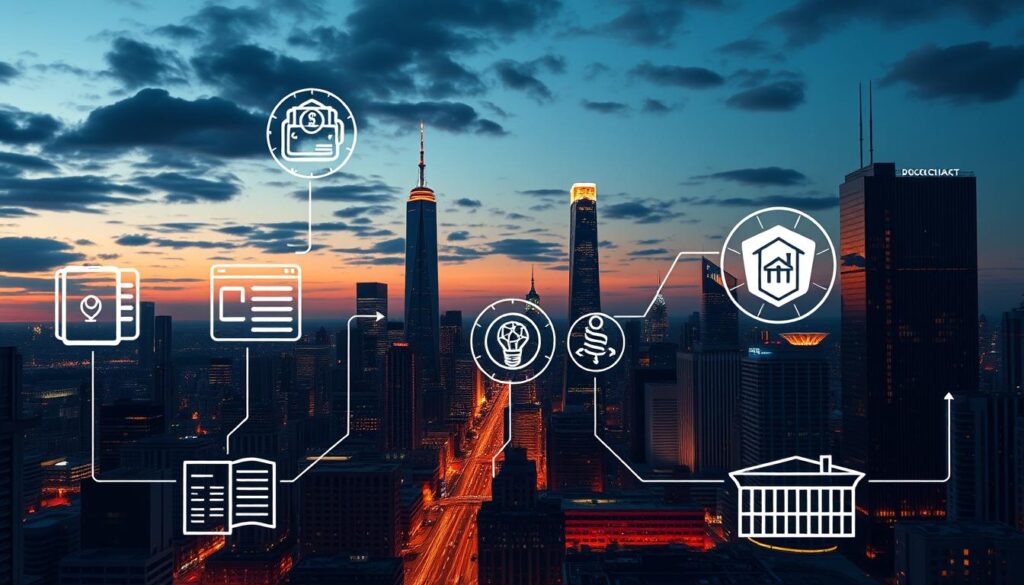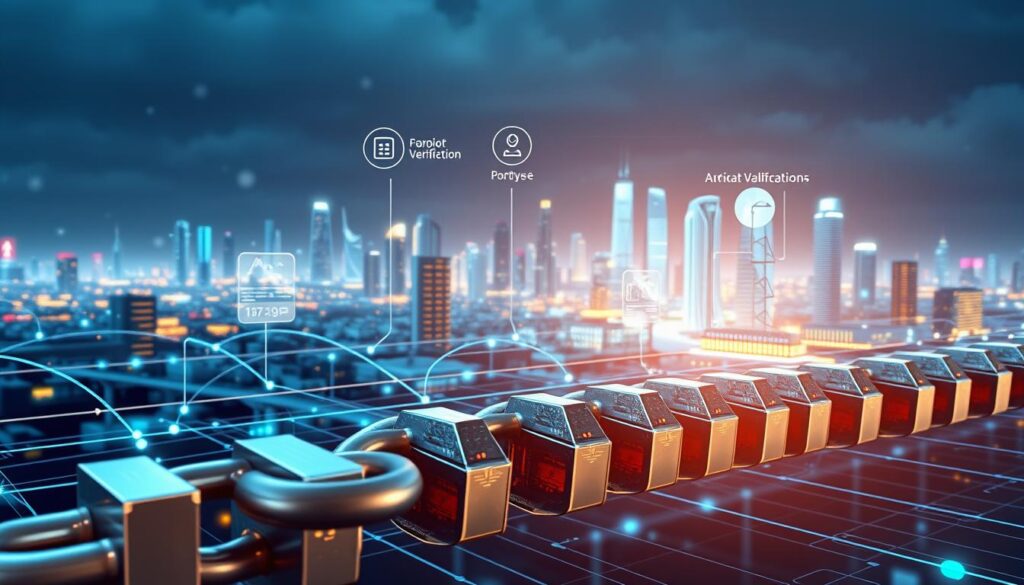Now Reading: AI Blockchain Scalability Performance Optimization Strategies
- 01
AI Blockchain Scalability Performance Optimization Strategies
AI Blockchain Scalability Performance Optimization Strategies

Modern decentralized systems face significant challenges as they grow in complexity and usage. The convergence of artificial intelligence with distributed ledger technology represents a powerful solution to these obstacles.
Blockchain networks have revolutionized how we handle digital transactions and data integrity. However, as adoption increases across financial services and enterprise applications, traditional systems struggle to maintain efficiency.
This guide explores how intelligent systems enhance distributed networks. Machine learning algorithms and predictive analytics offer new approaches to longstanding limitations. These technologies work together to create more responsive and capable decentralized platforms.
The integration of smart computational methods with secure ledger systems creates unprecedented opportunities. Organizations can now build more robust applications that handle increased demand without compromising security or transparency.
Readers will discover practical implementation strategies and real-world examples. These approaches demonstrate how next-generation applications can achieve new levels of efficiency and reliability.
Key Takeaways
- Artificial intelligence enhances blockchain network capabilities through intelligent automation
- Scalability challenges in decentralized systems require innovative solutions
- Machine learning algorithms optimize transaction processing and resource allocation
- Predictive analytics help prevent bottlenecks in high-throughput applications
- Integration of these technologies enables next-generation decentralized platforms
- Practical implementation strategies exist for various industry applications
- These approaches maintain security while improving system performance
Introduction and Overview
Today’s technological landscape is being reshaped by the powerful synergy between adaptive intelligence and secure distributed platforms. This combination creates new possibilities for digital systems that were previously unimaginable.
Exploring the convergence of AI and blockchain
The integration of artificial intelligence with distributed ledger technology represents a transformative development. These systems work together to create more intelligent and efficient platforms.
Machine learning algorithms enhance network operations while maintaining data integrity. This combination addresses critical needs in modern digital infrastructure.
Setting the stage for scalability and performance challenges
Despite the potential, significant hurdles remain in achieving widespread adoption. Both technologies demand substantial computational resources when combined.
These challenges require innovative approaches to scaling the future of distributed systems. Organizations must balance efficiency with security and transparency.
| Traditional Approach | Modern Integration | Key Benefits |
|---|---|---|
| Centralized data processing | Distributed intelligent analysis | Enhanced security and transparency |
| Manual optimization | Automated predictive adjustments | Improved system performance |
| Static resource allocation | Dynamic adaptive distribution | Better handling of data volumes |
Understanding Blockchain Scalability Challenges
Before distributed systems can power global applications, they must solve the puzzle of handling massive transaction volumes efficiently. This capacity for growth, known as scalability, is a core hurdle. Public networks like Bitcoin and Ethereum face unique limitations because of their decentralized design.

Transaction Throughput and Latency Issues
A major challenge is low transaction throughput. Early-generation networks process only a handful of transactions per second. This creates a vast gap compared to traditional payment systems.
Latency, or confirmation time, is another critical issue. Consensus mechanisms that secure the chain require extensive validation. This process can take from minutes to hours during peak demand, making real-time use impractical.
Data Storage Limitations and Security Concerns
As these networks grow, so does the ledger size. Storing and validating this ever-increasing historical data becomes expensive and slow. This can reduce the number of active nodes, potentially affecting decentralization.
Security concerns are magnified when scaling. Attempts to increase speed or reduce validation can create vulnerabilities. The scalability trilemma suggests that improving one aspect often comes at the cost of another, like security or decentralization.
AI blockchain scalability performance optimization
Machine learning approaches transform traditional consensus validation by introducing adaptive intelligence that responds to real-time network conditions. These smart systems analyze patterns to predict future demands and adjust operations accordingly.

Role of AI in Predictive Analytics and Adaptive Consensus
Predictive modeling revolutionizes how distributed networks handle validation. Machine learning algorithms forecast node behavior patterns, reducing unnecessary security checks.
This approach maintains strong protection while streamlining operations. Networks achieve faster transaction finality with lower computational costs.
Adaptive consensus mechanisms dynamically adjust protocol parameters. They balance security needs with efficiency based on current network load.
| Traditional Approach | AI-Enhanced Approach | Key Benefits |
|---|---|---|
| Fixed validation rules | Dynamic parameter adjustment | Improved resource utilization |
| Uniform security checks | Risk-based validation | Faster processing times |
| Static node evaluation | Predictive behavior analysis | Enhanced system reliability |
Reinforcement learning algorithms continuously refine consensus strategies. They identify optimal validation paths through trial and error.
This progressive learning reduces latency and resource consumption. The system adapts to changing transaction patterns and network dynamics.
Innovative Optimization Strategies for AI and Blockchain
Forward-thinking developers are implementing cutting-edge approaches to enhance distributed ledger capabilities. These advanced methods address critical limitations while maintaining system integrity.
Modern solutions combine intelligent automation with secure distributed platforms. This creates more responsive and efficient digital ecosystems.
Dynamic sharding and intelligent resource allocation
Dynamic partitioning represents a significant advancement in network management. Smart algorithms continuously analyze workload patterns across the entire system.
These systems automatically reconfigure segments to distribute processing demands evenly. This prevents bottlenecks while maintaining optimal transaction throughput.
Intelligent resource distribution uses predictive models to forecast computational needs. Tasks are dynamically allocated based on each node’s capacity and historical performance.
This approach maximizes overall network efficiency while preventing resource exhaustion. System stability remains protected during peak usage periods.
Smart caching and network optimization techniques
Layer 2 solutions process transactions outside the main ledger before aggregation. This dramatically reduces congestion on the primary chain.
Smart caching anticipates data access patterns through predictive analytics. Frequently requested information is positioned closer to where it’s needed.
Network enhancement strategies monitor peer-to-peer communication patterns continuously. They identify suboptimal routing and automatically adjust configurations.
Data reduction techniques identify redundant historical information for safe removal. Compression algorithms optimize storage while maintaining full data fidelity.
Predictive maintenance systems forecast potential failures before they occur. This ensures uninterrupted operations and maintains network reliability.
Real-World Applications and Use Cases
From financial services to global supply chains, real-world deployments showcase how adaptive technologies transform traditional processes. These practical implementations demonstrate tangible benefits across multiple industries.

Decentralized finance platforms handle enormous transaction volumes daily. Intelligent systems predict network congestion patterns to maintain smooth operations.
Enhancing DeFi and Supply Chain Management Processes
Financial applications require robust security while processing numerous transactions. Smart solutions dynamically adjust fees during peak usage periods.
Supply chain management benefits from transparent tracking systems. These platforms enable real-time visibility across complex distribution networks.
Goods move efficiently from origin to destination without bottlenecks. Data flow optimization ensures seamless operations throughout the entire chain.
Boosting IoT Ecosystems and Data Sharing Efficiency
Internet of Things networks involve millions of connected devices generating continuous data streams. Advanced platforms manage this volume effectively.
Projects like SingularityNET create decentralized marketplaces for computational services. Their token systems facilitate smooth transactions between participants.
Ocean Protocol enables secure information exchange across organizations. These ecosystems reward data sharing while maintaining privacy standards.
Healthcare and enterprise systems also benefit from these integrated approaches. They create auditable records while improving operational efficiency.
Future Trends, Challenges, and Integration Strategies
Emerging computational paradigms are reshaping how we approach decentralized network limitations. These advanced systems combine intelligent processing with secure distributed frameworks.

Next-generation technologies offer transformative potential for addressing current constraints. Quantum computing represents a particularly promising development for complex problem-solving.
Emerging technologies like Layer 2 solutions and quantum computing
Layer 2 frameworks continue evolving as critical infrastructure components. These solutions process transactions outside primary networks while maintaining security guarantees.
Specialized hardware accelerators are emerging to handle unique computational tasks. These dedicated chips dramatically improve processing speed while reducing energy consumption.
Quantum systems offer unprecedented computational power for optimization challenges. However, they also introduce new security considerations that require advanced cryptographic protocols.
| Current Challenge | Emerging Solution | Key Advantage |
|---|---|---|
| Network congestion | Advanced Layer 2 frameworks | Increased transaction throughput |
| High energy demands | Specialized hardware chips | Reduced power consumption |
| Complex optimization | Quantum computing approaches | Faster problem resolution |
Strategies for overcoming performance bottlenecks and ensuring interoperability
Interoperability remains a significant challenge across different platform architectures. Future integration approaches must create standardized communication protocols.
Transparency requirements present additional considerations for intelligent systems. Decision-making processes must maintain auditability across distributed networks.
Regulatory compliance represents an evolving consideration for combined technologies. Systems must adapt to varying legal frameworks across different jurisdictions.
Technical complexity requires specialized expertise spanning multiple domains. Educational initiatives and development tools can help broaden accessibility.
Conclusion
Digital transformation reaches new heights when predictive analytics meet the immutable security of decentralized networks. This powerful combination addresses fundamental limitations that have hindered widespread adoption across enterprise applications.
Intelligent systems enhance transaction processing while maintaining core principles of security and transparency. Real-world implementations across finance and supply chains demonstrate tangible benefits in efficiency and cost reduction.
As emerging technologies mature, this integration will unlock even greater potential. Organizations should strategically explore these solutions to gain competitive advantage in evolving digital landscapes.
The future promises innovative applications that redefine what’s possible with secure distributed platforms. Early adopters position themselves for enhanced operational capabilities and reduced costs.
FAQ
How does artificial intelligence improve transaction throughput in blockchain networks?
AI enhances throughput by using predictive analytics to forecast network load. It can dynamically adjust consensus protocols, like those used by Ethereum, to process more transactions per second. This reduces latency and increases overall system efficiency.
What are the main data storage limitations when integrating AI with distributed ledger technology?
The primary challenge is the immense data consumption of machine learning models. Storing this data on-chain can be costly and slow. Solutions often involve hybrid models, using off-chain storage from providers like AWS or IPFS, while keeping critical hashes on the main chain for verification and transparency.
Can these optimization strategies be applied to supply chain management platforms?
Absolutely. In supply chain applications, intelligent resource allocation can track goods in real-time. Smart caching reduces data retrieval times, while adaptive mechanisms ensure all parties in the ecosystem have access to verified information, boosting trust and operational efficiency.
What role do Layer 2 solutions play in overcoming performance bottlenecks?
Layer 2 solutions, such as Bitcoin’s Lightning Network or Polygon, handle transactions off the main chain. AI can optimize this by intelligently routing transactions to the most efficient layer. This strategy alleviates congestion on the primary network, lowering costs and improving speed for users.
How is security maintained when using machine learning for adaptive consensus mechanisms?
Security remains a top priority. AI algorithms are trained for anomaly detection to identify potential threats. These systems work within established security protocols to ensure that any adaptive changes to the consensus model do not compromise the network’s integrity or resistance to attacks.














